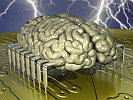Towards a Bi-Directional Neural Prostheses for the Central Nervous System |
||||||
 |
Introduction |
|||||
Current Neural Prostheses SystemsCurrently there are several different types of neural prostheses systems that are available to patients that have lost the normal functionality of sensory and motor function. These functionalities include auditory hearing loss which is corrected with the aid of cochlear implants, visual loss which is corrected with the aid of retinal implants that are mainly in the research and developmental phase, loss of motor control which is corrected with the use of functional electrical stimulation (FES) in the case of paralyzed limbs or with the use of deep brain stimulation (DBS) when dealing with the symptoms of neurological disorders such as Parkinson’s disease. Please see websites created by other BME 240 students for more information in regards to Functional Electrical Stimulation Cochlear Implants are implantable devices which are used to stimulate the auditory nerves when damage has occurred to the hair cells located in the cochlea of the inner ear. They consist of an array of electrodes that are placed into the snail-shaped cochlea. Due to the tonotopic organization of the cochlea when different electrodes on the array are stimulated, they stimulate the corresponding nerve fibers. These nerve fibers will send action potentials to the brain and these are perceived as sound just like in a normal human ear. For more information on auditory implants please use the following link. What Makes a Bi-Directional Neural Prostheses Different?The above mentioned neural prostheses systems do a great job in attempting to restore sensory and motor control loss. However, these systems are only able to perform uni-directional communication. For example, in the case of cochlear implants, retinal implants and DBS electrical signals are transduced to the brain to be processed. In the case of FES, preprogrammed stimulation patterns are used to stimulate muscles in order to emulate movement [1]. Bi-directional implants on the other hand, are the next frontier in the development of neural prostheses systems as they are ideal for replacing higher order brain functions typically observed in the central nervous system [1]. Neural prostheses systems for the central nervous system will potentially be able to restore cognitive losses that occur due to central brain region damage. These systems will be capable of taking as inputs electrical activity from various regions in the brain, processing these inputs in a manner that mimics the original neural tissue of the brain region and sending as output electrical activity to various regions of the brain [2]. Below is a schematic of how such a prostheses would function in the body [1]. | ||||||